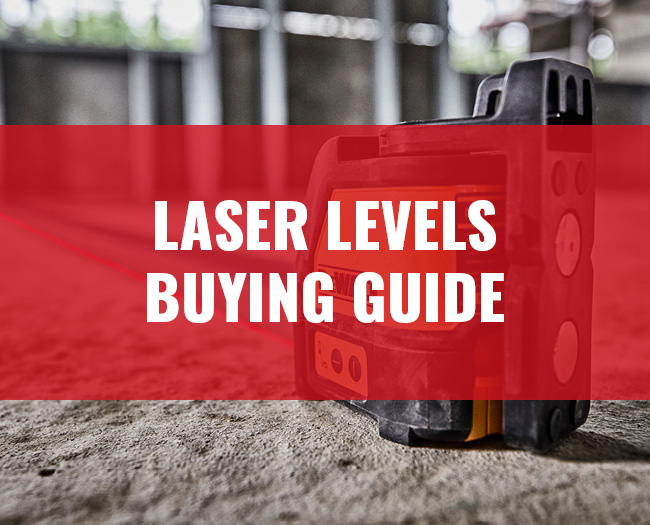Knowing which laser level you need for which job is absolutely key as there are a vast array of products that are designed to do very different things. Some laser levels are designed with specific jobs in mind such as flooring levels (unsurprisingly geared towards making floors level) whilst there are others that have multiple applications like cross line and rotary lasers.
In any case, there is a solution for all with a wide selection of price points. Let’s get into it and take a deeper look at the types of lasers currently available and once you’ve decided what’s right for you, visit the laser level section of our site! Any, let’s see what’s what…
Which laser level does what?

Cross Line Lasers
Cross line lasers project horizontal and vertical laser lines producing a cross on the work surface. This is extremely useful for when you need precise right angles when tiling onto walls and installing fixtures such as kitchen cabinets and shelves. Cross lines may be the primary function of these lasers, but you can also turn either the horizontal or vertical lines off independently – giving you a single laser line for general usage. These lasers are also available with pulse mode which, with use of a detector (see below for more information on them), means you can pick up a level point when the laser isn’t visible to the human eye. This is designed for when you’re working outside or in bright light.
Typical use of cross line lasers:
- The layout and installation of electrical/plumbing systems.
- The precise installation of kitchen cabinets, shelving and fixtures.
- The fitting of tiles onto walls.
- The installation of partition walls and drop ceilings
Example products:

Rotary Lasers
Rotary lasers produce a 360° laser line over longer distances than other line lasers, making them ideal for large projects such as the levelling of whole work sites. A single laser diode spins rapidly to create the impression of a constant line on work surfaces so you aren’t limited to a single direction at which the laser is pointed – the laser line will appear all around you. These lasers are generally designed for creating horizontal lines but there are models that can also work vertically. As with the cross line lasers, using a detector gives added benefits. Not only can you relax when the laser’s visibility is compromised, but a detector will be able to extend your working range – making large projects easy to level off.
Typical use of rotary lasers:
- The installation of drop ceilings & partition walls.
- The installation of electrical and lighting layouts
- The general levelling and layout of work sites.
- The levelling of concrete building foundations.
Example products:

Plane Lasers
These lasers combine the advantages of cross lines and rotary lasers as they project a permanent and solid 360° laser line both vertically and horizontally. This convenience is at the expense of its practical working range as this is reduced in comparison to rotary lasers. On the other hand, the strength of the laser is much clearer in plane lasers – they are designed to be much more of an indoor piece of kit as opposed to rotating lasers. So if you only work over short distances and don’t want the hassle of using a detector, this is the kind of laser for you.
Typical use of plane lasers:
- The accurate installation of building framework for dry-walls, cupboards, shelving, etc.
- The transference of points for cable installation and laying out electrical systems.
- Laying out for pipe work and ducting.
- The Installation of window frames.
- The installation of kitchen cabinets, shelving and fixtures.
- The fitting and laying out of kitchen and bathroom tiles on floors and walls.
Example products:

Dot Lasers
These lasers are quite different from the other kids on the block. They project an exact dot instead of a full line, giving you the exact angles between different points. Various dot lasers project dots at 2 points for verticals, 3 points for verticals plus horizontal or 5 points for verticals, horizontals and 45° in-between. These are all displayed simultaneously so – for example – you can have exact angles between a wall, the floor and the ceiling. These machines are also referred to as “Plumb Bob” lasers as they give plumbers the accuracy they need when installing piping but many tradesmen have found them useful in many applications.
Typical use of dot lasers:
- The installation of lighting systems and the levelling of electrical sockets.
- Laying out for pipe work and ducting and the hanging of heating conduit
- The adjustment of guide rails for drop ceilings.
- Hanging cupboards & hanging shelves (level on different walls).
- The installation of partition walls or door frames.
Example product:

Flooring Lasers
Flooring lasers are used to ensure that a floor is completely level before the installation of flooring. These types of lasers can highlight irregularities in the height of a surface so are an absolute must for surveyors and flooring tradesman. As such, they are generally for interior use.
Typical use of flooring lasers:
- The installation of under-floor heating.
- Checking a floor is level before laying wooden flooring or tiles
- To determine if an uneven floor may be causing problems.
Example products:

Layout Line Lasers
Layout line lasers are the perfect tools for all the tilers out there as they throw laser lines onto floors and walls at 90° and sometimes 45°. Like flooring lasers, they are generally used inside but would be useful when laying paving outside to ensure the angles are correct and aesthetically pleasing.
Typical use of layout line lasers:
- Alignment of wall or floor tile.
- The laying of electrical cables on the floor.
- Pipe work layout
Example product:

Laser Detectors
As previously mentioned, the visibility of most lasers is significantly reduced when working outdoors or in bright conditions. Certain lasers can counteract this problem by using a pulse mode which laser detectors are able to pick up over large distances. In fact, the workable distance of the laser can be increased to triple in some cases. It’s well worth bearing in mind that only certain lasers will accept detectors so be sure to check the specification of detectors and lasers to ensure you’re not disappointed!
Typical use:
- To extend the working range of applicable lasers.
- Allows lasers levels to be used in bright light when the laser itself is hard to see
Example products:
Time for a recap on which laser level you need…
For tilers, plumbers, electricians, kitchen fitters, drywall installers and flooring specialists these intelligent measuring tools are an absolute must. It’s definitely worth taking the time and effort to research which product is right for your needs and we hope that this guide steers you in the right direction.
If you’re still not sure on what laser level is right for you, ITS are here to help! Head over to our Laser Level section of our website right here to see our latest range… Our tool experts are always on hand for advice and guidance on getting the product you need, all you need to do is give us a call on 020 8532 5000.
If you have any questions, please pop them in the comments section below or alternatively, hit us up on Facebook or Twitter now!


I like the helpful information you provide in your articles.
I’ll bookmark your weblog and check again here regularly.
I am quite sure I will learn plenty of new stuff right here!
Best of luck for the next!
Hey There. I found your blog using msn. This is a really well written article.
I’ll be sure to bookmark it and return to read more of your useful info.
Thanks for the post. I’ll definitely return.
I’m truly enjoying the design and layout of your site.
It’s a very easy on the eyes which makes it much more enjoyable for me to come here and visit more often. Did you hire out a designer to create
your theme? Exceptional work!